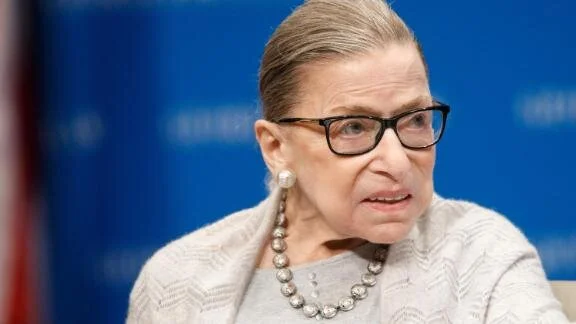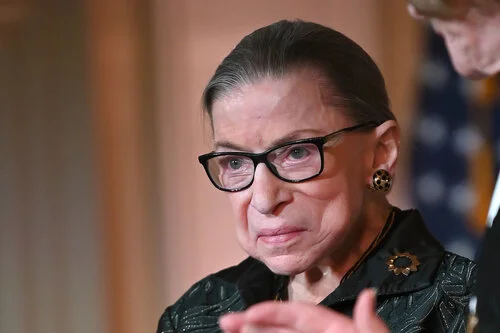On the life and career of Ruth Bader Ginsburg By Daniel Tagliarina
Justice Ruth Bader Ginsburg, the second woman, and first Jewish woman, ever to serve on the United States Supreme Court, died on Friday. While the timing of this has widespread implications for the current election cycle, the future balance of the Court, and many pressing rights issues, these issues are not what this piece is about. Instead, this piece is about paying respects to Ginsburg, herself, and her lasting impact on the law. This is about respecting a monumental career, and the achievements of the person who was the 107th justice to be confirmed to the Supreme Court, but only the 2nd woman to hold this honor. As people mourn the death of the person who had become affectionately referred to as “the Notorious RBG,” it is worth celebrating her remarkable accomplishments.
Much of Ginsburg’s career-long struggles for women’s rights were evidenced in many of the challenges she had to face throughout her education and career. Ginsburg attended law school at a time, pre-Title IX, where women were rarely admitted, and once there, were often berated for choosing to join a male-dominated profession. Ginsburg was one of only nine women in her entire class at Harvard Law. Even then, she faced criticism from classmates and law professors that it was wrong of her to “steal” a spot from a more deserving man. Despite this, she became the first woman to be a member of the Harvard Law Review. While she completed her final year of law school at Columbia Law—she transferred because her husband was working in New York City—she also served on the Columbia Law Review and graduated first in her class. On top of that, she did all of this while caring for her children and helping her husband through his own struggles with cancer.
Photo from WKTV
Despite graduating top of her class, Ginsburg continued to face discrimination in employment as many places simply refused to hire women. The fact that things are not as bad now as they were then is the result of many people’s tireless activism, and this includes Ginsburg’s work with the Women’s Rights Project of the American Civil Liberties Union (ACLU) in the 1970s, which she helped found. In this capacity she argued six cases before the Supreme Court that sought to expand protections from discrimination for people regardless of their gender or sex, while working on the written briefs for numerous other cases as well. Through these arguments and cases, Ginsburg chipped away at the ideas and practices that allowed for individuals to legally treat men and women differently simply by virtue of their sex.
It is through the work of Ginsburg, and others, that women can sign a mortgage without a man, that women can have a bank account without a male co-signer, that women can have a job without being discriminated against on the basis of sex, that women can be pregnant or have children and continue to work, that women have a right to pension equal to that of a man working the same job, that women must be included on juries at rates comparable to men, the male spouses of women in the military are entitled to the same benefits as wives of men in the military, and that widowers who were men would also be eligible for social security benefits. As an attorney, Ginsburg played a role in 34 different Supreme Court cases, directly arguing 6 of them before the Court, and having her clients win 5 of those 6 cases.
Ginsburg’s impact on the law, and in particular on gender- and sex-based discrimination was profound. Before her cases started making their way to the Court, the justices upheld every single law that was challenged on the grounds that it discriminated on the basis of sex. While Ginsburg and her colleagues were not able to convince the Court to treat discrimination on the basis of sex with the same skepticism as race-based discrimination is treated, she was able to convince the Court to offer higher protections to—and higher criticisms of—any laws that treat men and women differently.
Photo from National Archives
Ginsburg was eventually nominated to the U.S. Court of Appeals for the District of Columbia by President Carter in 1980. While serving here, President Clinton nominated Judge Ginsburg to serve on the U.S. Supreme Court in 1993, earning a quick confirmation and becoming only the second women to serve on the Court. While serving on the Court she remained firmly committed to a view of the law that supported the rights of minorities and marginalized peoples. She consistently supported the rights of women, the LGBTQ+ community, racial minorities, people within the criminal justice system, and protections of voting rights. Her life and career where driven by a communal view of justice, and the need to foster an inclusive society.
Perhaps her most well-known majority opinion, building off many of the cases that she had argued as a lawyer, was the 1996 case U.S. v. Virginia. Writing for the 7-1 majority, Ginsburg argued that it was unconstitutional under the 14th Amendment for the Virginia Military Institute (VMI) to maintain a male-only admissions policy. No comparable institution offered to women what VMI offered to men, and to deny women this opportunity violated the equal protection guaranteed to all under the 14th Amendment. Despite this important work, the Supreme Court’s continued ideological shift to the right meant that as time went on Ginsburg often found herself in the Court’s minority. After Justice Stevens retired in 2010, this also meant that Ginsburg became the most senior member of the more liberal justices, where she exerted her influence to have the justices articulate consistent, clear opinions voicing a specific approach to understanding the Constitution. Often, this was done in dissent, and often through a dissent supported by all of the more liberal justices. It was in a dissent to the Court’s striking down a portion of the Voting Rights Act that earned her the moniker “Notorious RBG” and propelled Ginsburg to pop culture icon status. Ginsburg viewed her role as a dissenter as one of preserving a record of a different approach to the law so that future generations of lawyers can build on this foundation. For her, it was about standing up for what is right, which often meant seeking to protect people’s rights and basic human dignity.
Despite all of the acclaim, and despite not being the most liberal justice on the Supreme Court, Ginsburg remained what she long had been: a tireless advocate for a view of the U.S. Constitution and law that was meant to be inclusive, that was meant to treat everyone equally, and that was meant to embrace our differences to create a more just, equitable society. She spent her life and career breaking down barriers for herself and others, and then helping others to not have to fight as many of the same fights as she had to just to get by. She is someone whose presence and impact far outstripped her diminutive frame. Her impact on the law—from both sides of the bench—is still felt today, and her death leaves a gaping hole in the Court. That someone who fought these fights, and made these changes possible, is a reminder that this is not a distant past, but rather reflective of recent changes in law and society. This is grounded experience that the Court now sorely lacks, and is likely to continue to go without. Justice Ginsburg represents what is possible when we push away outdated prejudices and offer people the chance to strive for a more inclusive society. Her legacy shall far out live her, and she will be greatly missed.
Daniel Tagliarina is Associate Professor of Political Science at Utica College.






